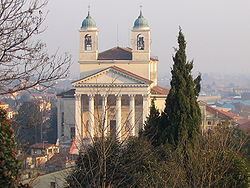Demonym(s) Scledensi Local time Friday 6:43 AM | Elevation 200 m (700 ft) | |
 | ||
Frazioni Aste, Cabrelle, Giavenale, Monte Magrè, Piane, Poleo, Santa Caterina, Santa Maria, San Rocco, Sant'Ulderico, Magrè, Liviera, Cà Trenta, Ss. Trinità, Santa Croce Weather 10°C, Wind NW at 10 km/h, 78% Humidity Points of interest Giardino Jacquard, Palazzo Fogazzaro, Lanificio Conte, Palazzo Toaldi Capra | ||
Schio is a town and comune in the province of Vicenza (region of Veneto, northern Italy) situated North of Vicenza and East of the Lake of Garda. It is surrounded by the Little Dolomites (Italian Prealps) and Mount Pasubio.
Contents
Map of 36015 Schio, Province of Vicenza, Italy
'"Which is Sheridan more like, Mantova or Verona or Vicenza?” “It isn't like any of those. It is right up against the mountains, almost like Schio.”
Ernest Hemingway
History
Its name comes from Latin: escletum was a wood of oaks and it was first used in a document of some Benedictines from Vicenza. The first settlements were around two old hills, where now there are respectively the ruins of an old castle and a majestic neoclassical cathedral.
By the 12th century Schio had become an important centre of prosperous wool manufacturing. The city was ruled by the Venetian Maltraversi family until 1311.
Schio is now an industrial town thanks to Alessandro Rossi, who founded the biggest Italian wool firm (Lanerossi) in the 19th century. Rossi also arranged the building of houses, nurseries, schools, theatres and gardens for his workers. The most important textile factories in Schio were Lanerossi, Conte and Cazzola. Schio was called "Manchester of Italy", because it was the focal point of the northern wool trade like the British city.
